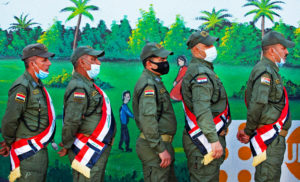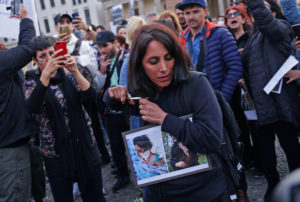Ayatollah Khomeini was a fundamentalist cleric who inspired the 1979 Islamic Revolution to overthrow a millennia-old history of Iranian monarchy. He was also, legend has it, an athletic young man who became the leapfrog champion of his village of Khomein and the surrounding area. Whenever I think of political change in modern-day Iran, it is the face of this surly mullah in the winter of his life that appears in my mind.
In 1979, furious Iranians marched in towns and cities across Iran, holding up pictures of Khomeini. Now they march once more: equally as enraged, equally as determined to bring revolution.
It’s been six weeks since protests broke out after the murder of Mahsa Amini, an Iranian-Kurdish woman, at the hands of Iran’s brutal and sinister morality police, uniting different parts of society across age, class, and ethnic boundaries. Women now burn their hijabs daily and cut off their hair. Parents boycott schools. Protestors continue to line the streets. All the while, Iran continues to be strafed by international sanctions, a failed nuclear deal, and spiralling inflation and unemployment. The people have had enough.
The regime, though, fights back. It has cut off the internet, desperate to strangle coordination between protests and to stifle the flow of information out of Iran. But that’s impossible: with the help of VPNs, social media is driving international awareness, with protests breaking out in solidarity across dozens of countries. Yet still the crackdown continues. Iran State TV and its various News Agencies are pumping out regime narratives almost 24/7. Forced “apologies” by protestors who have supposedly seen the error of their ways — after, I would guess, much torture — are now a daily feature on evening TV. And, of course, the killings never cease; the Norway-based Iran Human Rights organisation estimates that more than 200 Iranians have been murdered to date.
When I look at the Iranian protests in 2022, I cannot help but compare them to 1979. There are clear parallels: the fact the protestors just want the mullahs gone; the centrality of the hijab; a background of economic decline; rumours of Iran’s leader being weakened by cancer. But there is one difference this time: speed.
In January 1979, just a month before the revolution, Khomeini was still in exile, as he had been since 1963. From a cottage in Neauphle-le-Château, in the French countryside near Paris, Khomeini continued the work he’d begun in Iraq: recording revolutionary sermons, speeches, anti-Shah rhetoric, and the ideology of the Islamic Government onto cassette tapes, which were then sold in Europe and smuggled into Iran. These were then broadcast and duplicated by mosques and distributed — illegally, of course — throughout the country. It was through this system that Khomeini, who was obviously barred from appearing on Iranian media, was able to mobilise Iranians to action. It took him years.
Today, however, the thousands of Iranians pouring onto the streets are likely to have been mobilised in the space of just a few hours by communications technologies that did not exist in 1977-79. Yes, it is now harder than at any other point since internet came to Iran to access it properly. But the government’s ban is not total. Email providers, including Yahoo Mail and Mail.com, are blocked, but, for some reason, Gmail, iCloud, and ProtonMail are not. It’s tricky for the protestors to mobilise, but it’s not impossible.
On the face of it, this can only be good. A popular revolution can only succeed if it’s, well, popular. But digitally powered protests carry as many disadvantages as advantages and, when it comes to turning them into successful revolutions, counterintuitively, perhaps even more. Here, the benchmark is the ultimately unsuccessful 2011 Arab Spring, which took place in the age of early social media: when Facebook was already established and Twitter was booming, but Instagram was in its infancy. It has been called the Facebook Revolution and it bears comparison to Iran today — in particular the case of Egypt. There, protestors hoping to overthrow the dictator Hosni Mubarak endured many of the hardships Iranians have faced over the last decade or so: police brutality, electoral fraud, lack of political freedom and liberty, and economic turmoil.
Their response was clear: revolution, powered by social media. As Fawaz Rashed, an Egyptian protestor, described at the time: “We use Facebook to schedule the protests, Twitter to coordinate, and YouTube to tell the world.” The demonstrations kicked off on 25 January 2011, known as Police Day in Egypt, and never looked back. Facebook pages such as “We are all Khaled Said” — which gained 100,000 followers in three days after spreading images of a man murdered by Egyptian police for exposing on-duty drug taking — were key fora of the revolution. The #Jan25 hashtag became collective, digital rallying cries, unifying the people around the first protests before the Egyptian government blocked the internet for five days. It was all too much. Three weeks later, Mubarak resigned. The revolutionaries had won.
Or had they? Mubarak was gone. But who would replace him? Social media had enabled Egyptians to mobilise hundreds of thousands onto the streets. This gave Mubarak a choice: cling on to power through massacres of a scale unknown even in Egyptian history or back down. He chose the latter. But the structural strength of social media — its ability to transform every Egyptian protestor into their own mini-broadcaster, amplifying messages and helping to mobilise others — proved to be the revolution’s downfall. Social media is, by nature, diffuse. It is not built around the architecture of central nodes, be it states or, in the case of revolutions, leaders.
So, when Mubarak fell, there was no one to replace him. Millions across the world watched in awe and triumph as he scuttled from power. But the job was only half done. The revolutionaries had no one to replace him. They had no leader — only thousands of Facebook accounts that were incredibly effective in getting the message about Mubarak out, but obviously unable to govern in his place. The revolutionaries had meandered into a void, into which Muhammad Morsi and the Islamist Muslim Brotherhood gratefully stepped. A few years later, after attempting to make himself a de Facto Pharoah, he was overthrown by the former General Abdel Fattah el-Sisi — in essence a Mubarak Mark II.
Now contrast this with 1979. Many date the beginning of the 1979 Revolution to the January 1978 student protests in defence of Khomeini, after the government newspaper Ettela’at labelled him a “British Agent” in an article entitled “Iran and Red and Black Colonization”. Simply put, the revolutionaries built their protest around the figure of Khomeini. Indeed, the revolution was said to have succeeded when his plane from Paris touched down at Tehran airport on 1 February 1979.
Fast forward to today, and Mahsa Amini’s name has become shorthand for Iranian revolutionary aspiration; her hashtag has been tweeted millions of times. But she can never be more than a martyr. No leader has yet emerged. Instead, the protests are organised by different people or groups in different cities and towns on an almost ad hoc basis.
The truth is that if the mullahs were to collapse tomorrow, there are no signs that a democratic movement would sweep to power. Opposition groups such as the Mujahedin-e-Khalq have their supporters, but they remain far from being a government-in-waiting. It is far more likely that the security state — led by the Revolutionary Guard Corps — would step into the void and make apparent what is already largely a fact: that Iran is no longer a clerical state but is now ruled by a Praetorian Guard.
In 1979, Iranians held up images of Khomeini. In 2022, they tear them down. They know they want the regime gone but they have no one to hold up in its place. For a revolution to succeed, it’s not enough to be against someone; you have to be for someone else. It’s not enough that Khamenei loses. Someone else must win.
Until that time, the mullahs will continue to cling on as murderously and barbarously as they always have, and Iranians will continue to die. For years Palestinians would say they needed a Saladin. They were wrong. What they need is a Ben Gurion. What the Iranian revolutionaries need now more than anything else is a Khomeini. Until that happens, this will only ever be half a revolution.
Disclaimer
Some of the posts we share are controversial and we do not necessarily agree with them in the whole extend. Sometimes we agree with the content or part of it but we do not agree with the narration or language. Nevertheless we find them somehow interesting, valuable and/or informative or we share them, because we strongly believe in freedom of speech, free press and journalism. We strongly encourage you to have a critical approach to all the content, do your own research and analysis to build your own opinion.
We would be glad to have your feedback.
Source: UnHerd Read the original article here: https://unherd.com/




